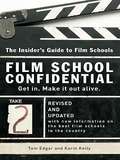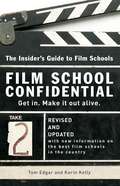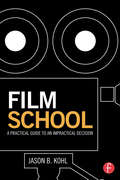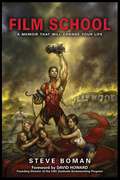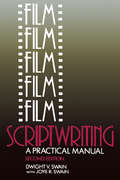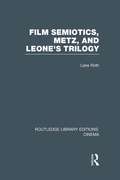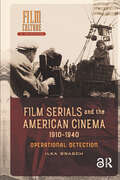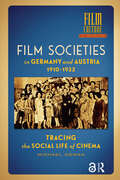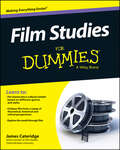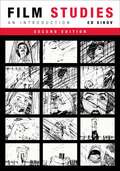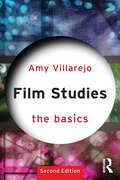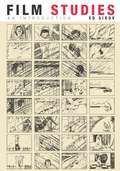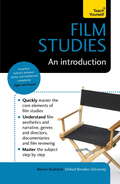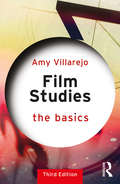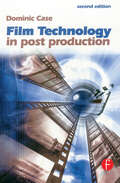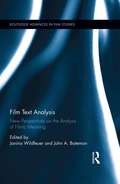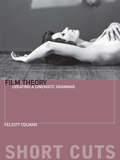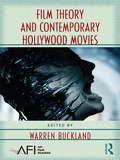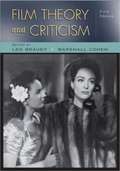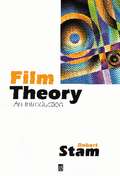- Table View
- List View
Film School Confidential
by Tom EdgarEvaluates twenty-six film school programs in the United States, offers tips on the application and admission process, and includes comments from students and faculty.
Film School Confidential: An Insider's Guide to Film Schools
by Karin Kelly Tom EdgarThis completely revised edition of Film School Confidential continues to offer the inside scoop on every major film school program in the country. A must-have guide for students who are considering applying to film school, this book provides more than 20 profiles of the best film school programs across the country. Covering such key areas as curriculum, student body, reputation, and employment options for film school grads, the authors provide solid, objective information on each program as well as snippets from interviews with students and faculty members.
Film School: A Practical Guide to an Impractical Decision
by Jason B. KohlDevelop the tools you will need to succeed before, during, and after your film school education. Film School: A Practical Guide to an Impractical Decision is a specific, straightforward guide to applying, getting into, and thriving in film school and in the industry in general. Not only does this book appeal to both prospective and current film students, it also features an in depth discussion of the application process, both from the graduate and undergraduate perspectives. You will learn how to choose between different schools and programs, avoid debt, succeed at festivals, and transition out of film school and into the work world. Author Jason Kohl offers: Tips on how to develop your voice before attending film school A chronological layout that allows you to continually refer to the book throughout your film school process Advice on how to gauge the cost of attending film school Whether you are a recent film school graduate, or just starting the application process, Film School gives important advice and insider knowledge that will help you learn and grow in the film industry. Film School is a must-have for anyone who wants to know what it takes to succeed in film school and beyond.
Film School: A Practical Guide to an Impractical Decision
by Jason B. KohlDevelop the tools you will need to succeed before, during, and after your film school education. Film School: A Practical Guide to an Impractical Decision is a specific, straightforward guide to applying, getting into, and thriving in film school and in the industry in general. Not only does this book appeal to both prospective and current film students, it also features an in depth discussion of the application process, both from the graduate and undergraduate perspectives. You will learn how to choose between different schools and programs, avoid debt, succeed at festivals, and transition out of film school and into the work world. Author Jason Kohl offers: Tips on how to develop your voice before attending film school A chronological layout that allows you to continually refer to the book throughout your film school process Advice on how to gauge the cost of attending film school Whether you are a recent film school graduate, or just starting the application process, Film School gives important advice and insider knowledge that will help you learn and grow in the film industry. Film School is a must-have for anyone who wants to know what it takes to succeed in film school and beyond.
Film School: The True Story of a Midwestern Family Man Who Went to the World's Most Famous Film School, Fell Flat on His Face, Had a Stroke, and Sold a Television Series
by Steve BomanOne L meets You'll Never Eat Lunch in This Town Again In this comic and moving and completely true tale, Film School reveals what life is like at the elite school that trained Hollywood's biggest names. When Midwestern journalist Steve Boman applied to the University of Southern California's vaunted School of Cinematic Arts, the world's oldest and most prestigious film school, he had more than a few strikes against him: His wife was recovering from thyroid cancer. His beloved sister had just died of leukemia. He lost his job. He had three young children. He was in his late 30s…. And he had no experience in filmmaking. As Boman navigates his way through USC's arduous three-year graduate production program, he finds that his films fall flat, he's threatened with being kicked out of the program and he becomes the old guy no one wants to work with. Defeated, he quits and moves back to the Midwest to be with his family. After he is urged by his wife to reapply, he miraculously gets in for a second time...only to have a stroke on the first day of classes. But instead of doing the easy thing – running away again -- Boman throws caution to the wind and embraces the challenge. He slowly becomes a gray-haired Golden Boy at USC with films that sparkle. And then he does the impossible: While still in school, for a class project, he dreams up a television series that CBS catches wind of and develops into THREE RIVERS, a primetime Sunday night show. This story of challenge and triumph—and what it takes to make it in the world's most famous film school—is a must-read for anyone aspiring to become a Hollywood great or anyone just looking for a good story.
Film Scriptwriting: A Practical Manual
by Dwight V Swain Joye R SwainThis second edition of the widely acclaimed Film Scriptwriting is a truly practical manual for the working writer. It provides all the clear, step-by-step guidance you need to script both fact and feature film and video - from getting and developing ideas to the writing of master scene or shooting script. Featured in this new edition are annotated excerpts from some of today's most successful films, selected to point up principles and techniques discussed. Interviews with working film specialists reveal the things professional directors, producers, story editor, and analysts look for in appraising the scripts that come across their desks.
Film Semiotics, Metz, and Leone's Trilogy (Routledge Library Editions: Cinema)
by Lane RothSemiotics offers a systematic approach to analysing the stylistic structure of film. When this study was originally published in 1983 this was a recent addition to the methods of film study and it presents an explanation of film semiotics with direct application to comparative film research. It takes as its representative subject one trilogy of films and applies semiology, with careful textual analysis. The book begins with a basic introduction to semiotics and the ideas of Christian Metz on cinesemiotics. It then presents a syntagmatic analysis of each of the three Dollars films, with an outline of autonomous segments for each and a discussion of the findings before undertaking a wider analysis of the trilogy as a whole with commentary on the stylistic unity of the director’s work. This book, an enduring detailed study of these three films, also outlines clearly this method of classifying the formal structuring codes of film communication.
Film Serials and the American Cinema, 1910-1940: Operational Detection (Film Culture in Transition)
by Ilka BraschBefore the advent of television, cinema offered serialized films as a source of weekly entertainment. This book traces the history from the days of silent screen heroines to the sound era's daring adventure serials, unearthing a thriving film culture beyond the self-contained feature. Through extensive archival research, Ilka Brasch details the aesthetic appeals of film serials within their context of marketing and exhibition, looking at how they adapted the pleasures of a flourishing crime fiction culture to both serial visual culture and the affordances of the media-modernity of the early 20th century. The study furthermore traces the relationship of film serials to the broadcast models of radio and television and thereby shows how film serials introduced modes of storytelling that informed popular culture even beyond the serial's demise.
Film Societies in Germany and Austria 1910-1933: Tracing the Social Life of Cinema (Film Culture in Transition)
by Michael CowanThis study traces the evolution of early film societies in Germany and Austria, from the emergence of mass movie theaters in the 1910s to the turbulent years of the late Weimar Republic. Examining a diverse array of groups, it approaches film societies as formations designed to assimilate and influence a new medium: a project emerging from the world of amateur science before taking new directions into industry, art and politics. Through an interdisciplinary approach—in dialogue with social history, print history and media archaeology—it also transforms our theoretical understanding of what a film society was and how it operated. Far from representing a mere collection of pre-formed cinephiles, film societies were, according to the book’s central argument, productive social formations, which taught people how to nurture their passion for the movies, how to engage with cinema, and how to interact with each other. Ultimately, the study argues that examining film societies can help to reveal the diffuse agency by which generative ideas of cinema take shape.
Film Studies For Dummies
by James CateridgeMake sense of the world of cinema Want to pull back the curtain on film? This hands-on, friendlyguide unravels the complexities of film and helps you put cinemainto a cultural context. You'll get an easy-to-follow introductionto different film genres and styles, learn about the history ofcinema, get to know who makes up a filmmaking team, explore globalcinema from Hollywood to Bollywood and much more.Film Studies For Dummies will open your mind to how thefilm industry works and help you to discover the impact of film onpopular culture. You'll get easy-to-read information on analyzingand critiquing film from a range of theoretical, historical andcritical perspectives, and learn how people communicate ideas infilm. You'll also be able to shine a light on how stories aredeveloped in movies, understand how a storyline is related tobroader issues in society and become a well-versed and insightfulfilm student.Covers the narrative, artistic, cultural, economic andpolitical implications of cinemaProvides conceptual frameworks for understanding a film'srelationship to realityExplores how people tell stories and communicate ideas infilmHelps you excel as a student of filmWhether you're planning to study film, a humanities student witha forthcoming module on film or a film enthusiast wondering if thismight be the future for you, Film Studies For Dummies hasyou covered.
Film Studies, second edition: An Introduction (Film and Culture Series)
by Ed SikovFilm Studies is a concise and indispensable introduction to the formal study of cinema. Ed Sikov offers a step-by-step curriculum for the appreciation of all types of narrative cinema, detailing the essential elements of film form and systematically training the spectator to be an active reader and critic. He treats a number of fundamental factors in filmmaking, including editing, composition, lighting, the use of color and sound, and narrative. His description of mise-en-scene helps readers grasp the significance of montage, which in turn reveals the importance of a director’s use of camera movement.Film Studies is designed for courses on film history, film theory, and popular culture. Its straightforward explanations of core critical concepts, practical advice, and technical, visual, and aesthetic aspects anchor the reader’s understanding of the formal language and anatomy of film and the techniques of film analysis.The second edition of this best-selling textbook adds two new chapters: “Film and Ideology,” which covers how to read a film’s political and social content, and other key topics in film theory, and “Film Studies in the Age of Digital Cinema,” which explores the central problems of studying film when “film” itself is no longer the medium.
Film Studies: A Global Approach (The Basics)
by Amy VillarejoFilm Studies: The Basics is a compelling guide to the study of cinema in all its forms. This second edition has been thoroughly revised and updated to take account of recent scholarship, the latest developments in the industry and the explosive impact of new technologies. Core topics covered include: The history, technology and art of cinema Theories of stardom, genre and film-making The movie industry from Hollywood to Bollywood Who does what on a film set Complete with film stills, end-of-chapter summaries and a substantial glossary, Film Studies: The Basics is the ideal introduction to those new to the study of cinema.
Film Studies: An Introduction
by Ed SikovEd Sikov builds a step-by-step curriculum for the appreciation of all types of narrative cinema, detailing the essential elements of film form and systematically training the spectator to be an active reader and critic. Sikov primes the eye and mind in the special techniques of film analysis. His description of mise-en-scene helps readers grasp the significance of montage, which in turn reveals the importance of a director's use of camera movement. He treats a number of fundamental factors in filmmaking, including editing, composition, lighting, the use of color and sound, and narrative. Film Studies works with any screening list and can be used within courses on film history, film theory, or popular culture. Straightforward explanations of core critical concepts, practical advice, and suggested assignments on particular technical, visual, and aesthetic aspects further anchor the reader's understanding of the formal language and anatomy of film.
Film Studies: An Introduction
by Warren BucklandAn unpretentious guide for all those who want to learn to analyse, understand and evaluate films. Film Studies: An Introduction provides an overview of the key areas in film studies, including aesthetics, narrative, genre, documentary films and the secrets of film reviewing. From Hitchcock and Tarantino to Spielberg and Bigelow, you will gain a critical understanding of legendary directors and the techniques and skills that are used to achieve cinematic effects. Whether you are a film studies student or just a film buff wanting to know more, this book will give you an invaluable insight into the exciting and incredibly fast-moving world of film. Understand Film Studies includes: Chapter 1: Film aesthetics: formalism and realism Chapter 2: Film structure: narrative and narration Chapter 3: Film authorship: the director as auteur Chapter 4: Film genres: defining the typical film Chapter 5: The non-fiction film: five types of documentary Chapter 6: The reception of film: the art and profession of film viewingfilm viewing Teach Yourself titles employ the 'Breakthrough method', which is designed specifically to overcome problems that students face. - Problem: "I find it difficult to remember what I've read."; Solution: this book includes end-of-chapter questions and summaries, and flashcards of key points available on-line and as apps - Problem: "Most books mention important other sources, but I can never find them in time."; Solution: this book includes key texts and case studies are summarised, complete with fully referenced quotes ready to use in your essay or exam. - Problem: "Lots of introductory books turn out to cover totally different topics than my course."; Solution: this book is written by a current university lecturer who understands what students are expected to know.
Film Studies: An Introduction (Film and Culture Series)
by Ed SikovEd Sikov builds a step-by-step curriculum for the appreciation of all types of narrative cinema, detailing the essential elements of film form and systematically training the spectator to be an active reader and critic. Sikov primes the eye and mind in the special techniques of film analysis. His description of mise-en-scene helps readers grasp the significance of montage, which in turn reveals the importance of a director's use of camera movement. He treats a number of fundamental factors in filmmaking, including editing, composition, lighting, the use of color and sound, and narrative. Film Studies works with any screening list and can be used within courses on film history, film theory, or popular culture. Straightforward explanations of core critical concepts, practical advice, and suggested assignments on particular technical, visual, and aesthetic aspects further anchor the reader's understanding of the formal language and anatomy of film.
Film Studies: An Introduction: Teach Yourself
by Warren BucklandAn unpretentious guide for all those who want to learn to analyse, understand and evaluate films.Film Studies: An Introduction provides an overview of the key areas in film studies, including aesthetics, narrative, genre, documentary films and the secrets of film reviewing. From Hitchcock and Tarantino to Spielberg and Bigelow, you will gain a critical understanding of legendary directors and the techniques and skills that are used to achieve cinematic effects. Whether you are a film studies student or just a film buff wanting to know more, this book will give you an invaluable insight into the exciting and incredibly fast-moving world of film.Understand Film Studies includes:Chapter 1: Film aesthetics: formalism and realismChapter 2: Film structure: narrative and narrationChapter 3: Film authorship: the director as auteurChapter 4: Film genres: defining the typical filmChapter 5: The non-fiction film: five types of documentaryChapter 6: The reception of film: the art and profession of film viewing
Film Studies: The Basics (The Basics)
by Amy VillarejoA comprehensive overview of how to study film, this updated third edition provides concise and provocative summaries for approaching the language of film analysis, ways of thinking about film history, and approaches and methods for studying cinema, from national cinemas to genre to stardom and beyond. The new edition tracks the changes in film production and exhibition by situating the study of film within contemporary digital media cultures and structures, such as social media and streaming platforms. Without forsaking its emphasis on the study of film, the third edition updates its examples and provides fresh insight into today’s image culture. Film Studies: The Basics provides beginning students in film studies, as well as lifelong film buffs, with the tools to pursue film analysis, film history, and further inquiries into the medium.
Film Technology in Post Production (Media Manuals Ser.)
by Dominic CaseAn easy to follow, quick reference introductory guide for beginning professionals and students in filmmaking and postproduction. It explains all film laboratory procedures in the context of the wide range of technology that is used by filmmakers, explaining what happens and why at every stage. A technical understanding of film processing and printing, telecine and laboratory and digital processes will help you get the best results for your film. The book is particularly useful for those who have come to film making from other media - video or digital. The book is based on the author's own experience as a lab technician and technical film consultant and provides answers to many frequently asked questions. The different pathways for film production and postproduction are demonstrated as well as the function of the lab at each stage of the process. The complete range of services is offered, with particular emphasis on the often confusing requirements for super 16 and the blow up to 35mm, the intricacies of negative cutting to match a non-linear edit and the process of grading and regrading for the answer print.This new edition includes:* An update on all digital formats of image and sound* Revision sections on Super 16, Super 35* Additional information on syncing rushes at telecine and to digital images* The latest telecine machines* A new, clear and simple glossary
Film Text Analysis: New Perspectives on the Analysis of Filmic Meaning (Routledge Advances in Film Studies)
by Janina Wildfeuer John A. BatemanThis book examines film as a multimodal text and an audiovisual synthesis, bringing together current work within the fields of narratology, philosophy, multimodal analysis, sound as well as cultural studies in order to cover a wide range of international academic interest. The book provides new insights into current work and turns the discussion towards recent research questions and analyses, representing and constituting in each contribution new work in the discipline of film text analysis. With the help of various example analyses, all showing the methodological applicability of the discussed issues, the collection provides novel ways of considering film as one of the most complex and at the same time broadly comprehensible texts.
Film Theory
by Felicity ColmanFilm Theory addresses the core concepts and arguments created or used by academics, critical film theorists, and filmmakers, including the work of Dudley Andrew, Raymond Bellour, Mary Ann Doane, Miriam Hansen, bell hooks, Siegfried Kracauer, Raul Ruiz, P. Adams Sitney, Bernard Stiegler, and Pier Paolo Pasolini. This volume takes the position that film theory is a form of writing that produces a unique cinematic grammar; and like all grammars, it forms part of the system of rules that govern a language, and is thus applicable to wider range of media forms. In their creation of authorial trends, identification of the technology of cinema as a creative force, and production of films as aesthetic markers, film theories contribute an epistemological resource that connects the technologies of filmmaking and film composition. This book explores these connections through film theorisations of processes of the diagrammatisation (the systems, methodologies, concepts, histories) of cinematic matters of the filmic world.
Film Theory
by Felicity ColmanFilm Theory addresses the core concepts and arguments created or used by academics, critical film theorists, and filmmakers, including the work of Dudley Andrew, Raymond Bellour, Mary Ann Doane, Miriam Hansen, bell hooks, Siegfried Kracauer, Raul Ruiz, P. Adams Sitney, Bernard Stiegler, and Pier Paolo Pasolini. This volume takes the position that film theory is a form of writing that produces a unique cinematic grammar; and like all grammars, it forms part of the system of rules that govern a language, and is thus applicable to wider range of media forms. In their creation of authorial trends, identification of the technology of cinema as a creative force, and production of films as aesthetic markers, film theories contribute an epistemological resource that connects the technologies of filmmaking and film composition. This book explores these connections through film theorisations of processes of the diagrammatisation (the systems, methodologies, concepts, histories) of cinematic matters of the filmic world.
Film Theory and Contemporary Hollywood Movies (AFI Film Readers)
by Warren BucklandFilm theory no longer gets top billing or plays a starring role in film studies today, as critics proclaim that theory is dead and we are living in a post-theory moment. While theory may be out of the limelight, it remains an essential key to understanding the full complexity of cinema, one that should not be so easily discounted or discarded. In this volume, contributors explore recent popular movies through the lens of film theory, beginning with industrial-economic analysis before moving into a predominately aesthetic and interpretive framework. The Hollywood films discussed cover a wide range from 300 to Fifty First Dates, from Brokeback Mountain to Lord of the Rings, from Spider-Man 3 to Fahrenheit 9/11, from Saw to Raiders of the Lost Ark, and much more. Individual essays consider such topics as the rules that govern new blockbuster franchises, the ‘posthumanist realism’ of digital cinema, video game adaptations, increasingly restricted stylistic norms, the spatial stories of social networks like YouTube, the mainstreaming of queer culture, and the cognitive paradox behind enjoyable viewing of traumatic events onscreen. With its cast of international film scholars, Film Theory and Contemporary Hollywood Movies demonstrates the remarkable contributions theory can offer to film studies and moviegoers alike.
Film Theory and Criticism: Introductory Readings (Sixth Edition)
by Leo Braudy Marshall CohenIn the thirty years since the first edition of this collection appeared in 1974-let alone the more than one hundred years since the first films were shown-the academic study of film has changed enormously, and the journalistic and popular criticism of film has been deeply affected as well. Yet many of the same issues that preoccupied and stimulated writers from the very beginning of film theory and criticism are still puzzling later generations: Is the filmed world realistic or artificial? Is film a language? Is its world best expressed in silence? in sound? through stories that may be derived from other arts? through stories that can be told only on film? Many of these questions were first formulated in critical language indebted to the methods and terminology of such humanistic disciplines as literary criticism, art history, and aesthetics. But early on, theorists began to emphasize the obligation to appreciate what was different, even unique, about film in comparison with the other arts: its formal qualities, its common need for enormous capital investment, and its relation to a mass audience.
Film Theory: An Introduction
by Robert StamThis book is a lively and provoking introduction to film theory. It is suitable for students from any discipline but is particularly aimed at students studying film and literature as it examines issues common to both subjects such as realism, illusionism, narration, point of view, style, semiotics, psychoanalysis and multiculturalism. It also includes coverage of theorists common to both, Barthes, Lacan and Bakhtin among others. Robert Stam, renowned for his clarity of writing, will also include studies of cinema specialists providing readers with a depth of reference not generally available outside the field of film studies itself. Other material covered includes film adaptations of works of literature and analogies between literary and film criticism.
Film Theory: Creating a Cinematic Grammar (Short Cuts)
by Felicity ColmanFilm Theory addresses the core concepts and arguments created or used by academics, critical film theorists, and filmmakers, including the work of Dudley Andrew, Raymond Bellour, Mary Ann Doane, Miriam Hansen, bell hooks, Siegfried Kracauer, Raul Ruiz, P. Adams Sitney, Bernard Stiegler, and Pier Paolo Pasolini. This volume takes the position that film theory is a form of writing that produces a unique cinematic grammar; and like all grammars, it forms part of the system of rules that govern a language, and is thus applicable to wider range of media forms. In their creation of authorial trends, identification of the technology of cinema as a creative force, and production of films as aesthetic markers, film theories contribute an epistemological resource that connects the technologies of filmmaking and film composition. This book explores these connections through film theorisations of processes of the diagrammatisation (the systems, methodologies, concepts, histories) of cinematic matters of the filmic world.
